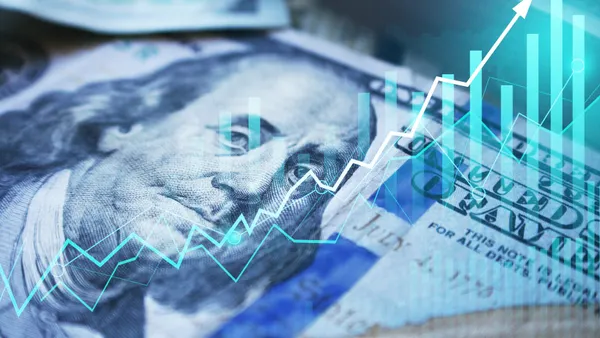Dive Brief:
- The producer price index inched down in August despite the nudge to inflation from high U.S. tariffs, bolstering the argument for the Federal Reserve to trim the main interest rate next week for the first time this year.
- The PPI, which measures prices paid to producers,unexpectedly declined 0.1%, with the cost of services falling 0.2%, the Bureau of Labor Statistics said Wednesday. The index rose 2.6% on an annual basis, exceeding the Fed’s 2% long-run inflation target.
- “The better-than-expected and relatively benign producer price report is both good news and bad news,” Scott Helfstein, Global X head of investment strategy, said in an email. “Input costs may be contained, but that could stoke fears of economic slowdown,” he said, predicting that the Fed will cut the main rate on Sept. 17.
Dive Insight:
The fresh PPI data differ from other recent signs that price pressures persist well above the Fed’s goal.
So-called core inflation, as measured by the personal consumption expenditures price index minus volatile food and energy prices, edged up to 2.9% in July.
The core consumer price index rose at a 3.1% annual rate in July. CPI data for August will be released on Thursday in the final major report on prices before Fed officials gather to discuss monetary policy on Sept. 16-17.
Traders in interest rate futures, responding to the PPI data, increased the odds that the Fed will cut the benchmark interest rate by at least 0.75 percentage points by December.
On Wednesday they saw a 73% probability of such an outcome compared with 69% odds on Tuesday, according to the CME FedWatch Tool. They saw zero odds that policymakers next week will hold the benchmark rate at its current range between 4.25% and 4.5%.
Fed officials in recent weeks have expressed concern about mounting signs of weakness in the job market and indicated that they lean toward loosening policy despite above-target inflation.
Some policymakers have also said recently that Trump administration tariffs will likely stir a temporary, rather than sustained, rise in price pressures.
“I am not seeing signs of amplification of second-round effects of tariffs on broader inflation trends,” New York Fed President John Williams said on Sept. 4.
Import duties will probably push up prices by between 1% and 1.5% before fading as an impulse to inflation by the second half of 2026, he said.
In an encouraging sign for price stability, long-run inflation expectations have remained stable, Williams said.
Consumers last month expected inflation to rise at 3% in three years and at 2.9% in five years, the New York Fed said Monday, reporting on results of a monthly survey.














